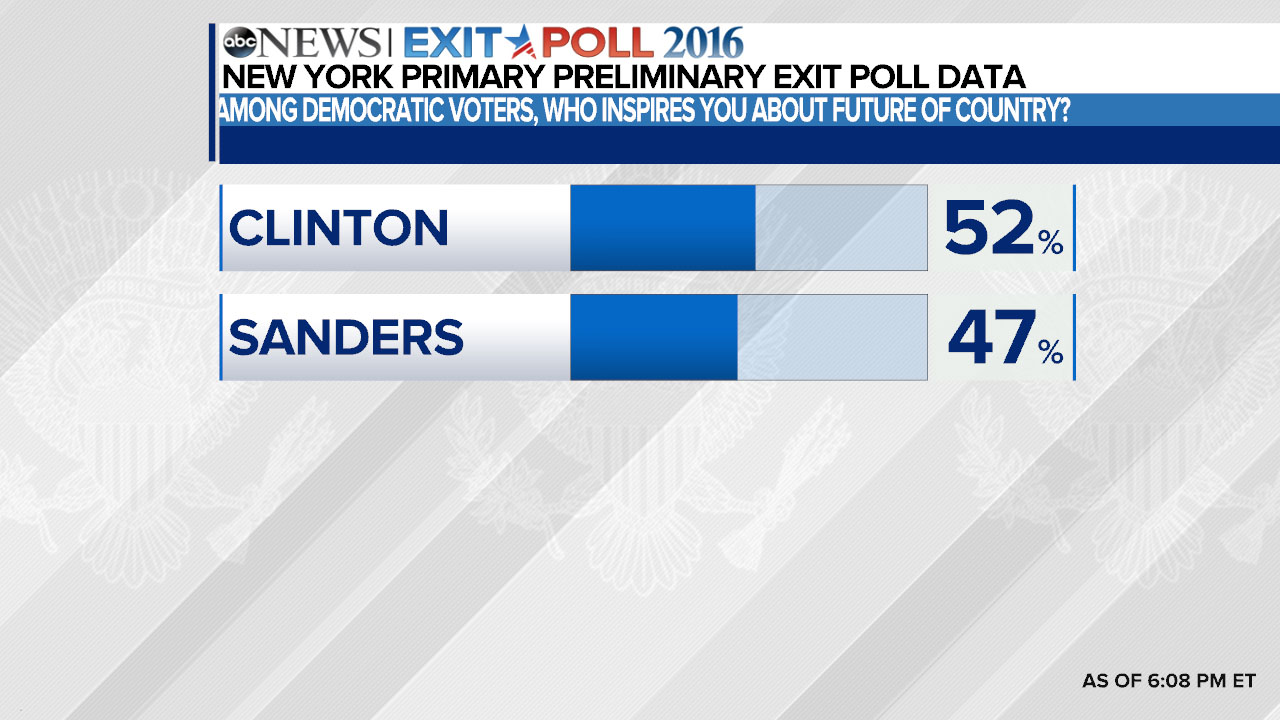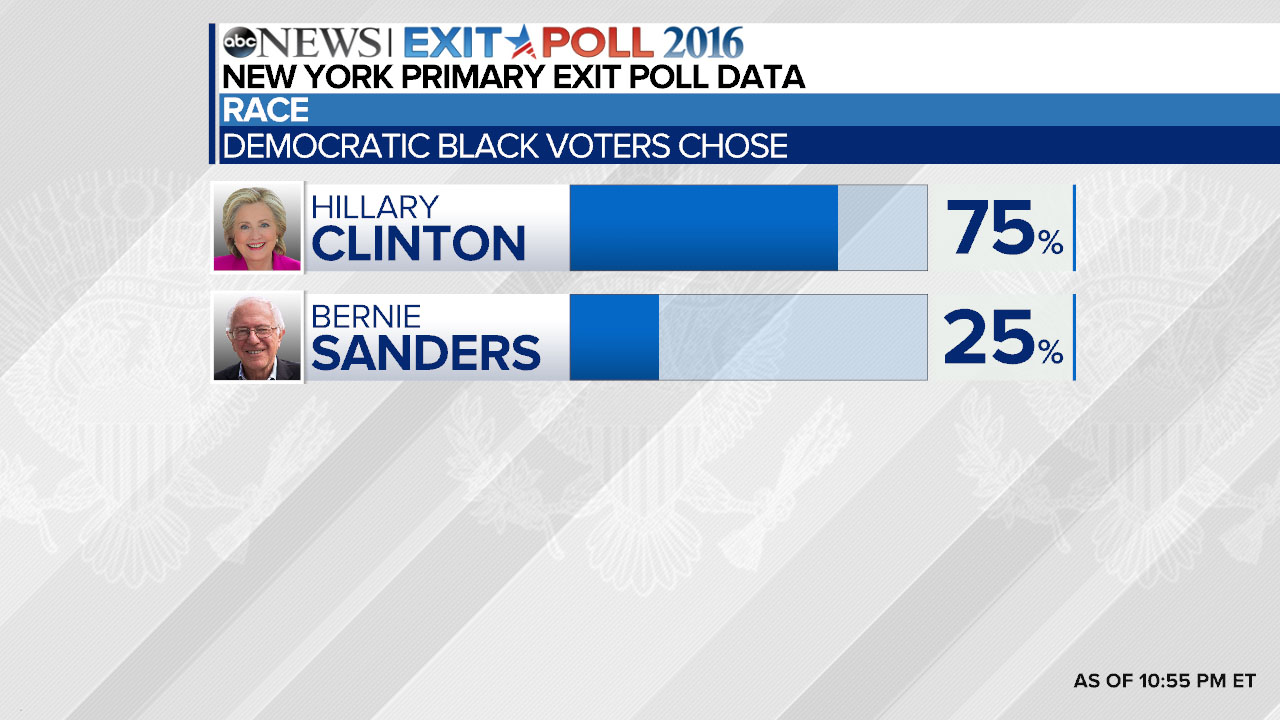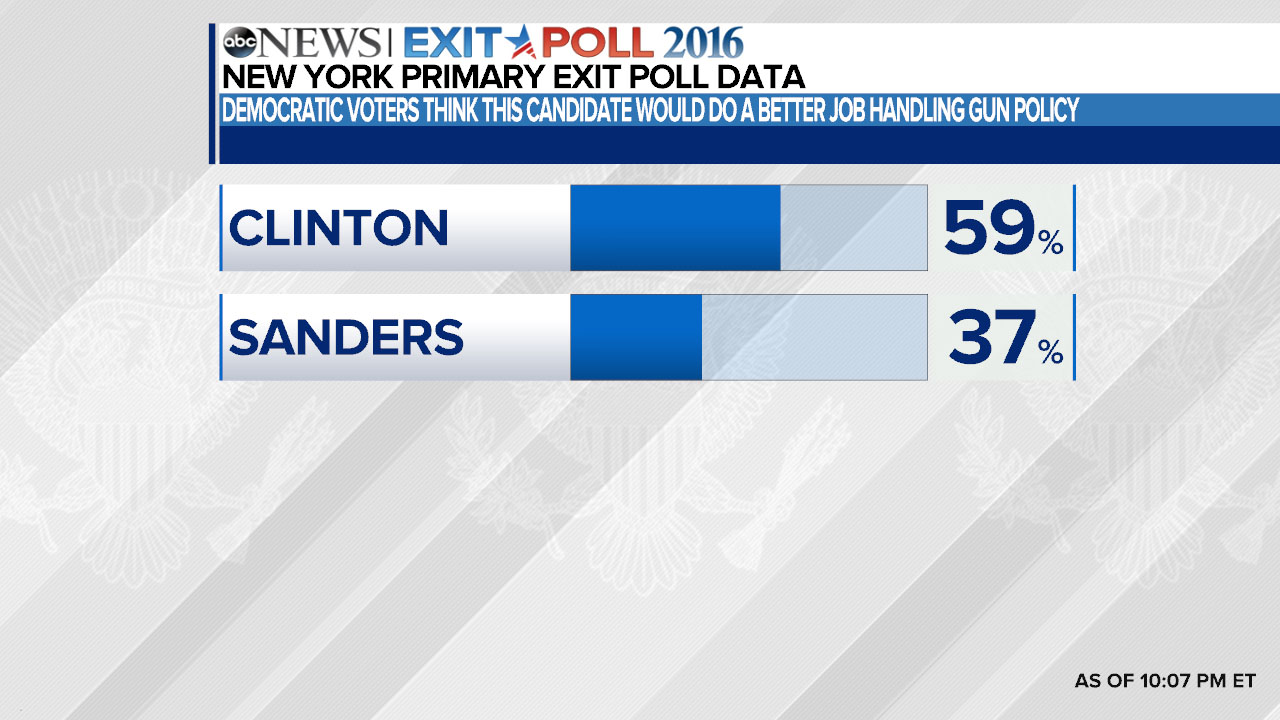New York Democratic Primary Exit Poll Analysis
Who turned out in Tuesday's New York primary and what motivated their votes?
— -- Who turned out in Tuesday's New York primary and what motivated their votes?
For all the answers, bookmark this page now or star it in the ABC News mobile app.
The ABC News Analysis Desk will be updating this page all night with live analysis of the exit polls.
Hillary Clinton’s resume, her position on gun policy, her support from women and New York Democrats’ racial and ethnic diversity all boosted her fortunes in the state’s presidential primary, but comparatively weak ratings for honesty dogged her – and Bernie Sanders pushed back with support from white men, young voters, strong liberals and those especially worried about the economy.
Inevitability, electability and inspiration: Among other factors, a sense of inevitability helped Clinton: Seven in 10 Democratic primary voters in preliminary exit poll results said they think she’ll be the ultimate nominee. Nearly two thirds, moreover, gave her a better chance than Sanders to beat Donald Trump in November. And Clinton ran about evenly with Sanders as being the more inspirational candidate, an attribute on which Sanders prevailed easily in his Wisconsin win.

Race and Gender: Racial and ethnic minorities accounted for nearly four in 10 voters in the state, vs. fewer than two in 10 in Wisconsin. Clinton won seven in 10 black voters and six in 10 Hispanics, according to preliminary exit poll results.

Clinton also had a substantial margin among women, albeit somewhat less than typical for her on average in primaries to date, while Sanders again won white men broadly, by about 20 percentage points. Sanders also won by more than a 2-1 margin among voters younger than 30, matching his average across primaries this year.

Religion: While we’ve noted the racial and ethnic diversity of New York Democratic primary voters, their unusual level of religious diversity also is worth nothing: Three in 10 Protestant, a quarter Catholic, a quarter professing no religion, one in 10 Jews, one in 10 other.
Partisanship: New York was more hospitable to Clinton in a range of ways. Its closed primary limited the number of political independents participating in the Democratic primary – fewer than two in 10, vs. 27 percent in Wisconsin and nearly as many in previous contests on average. Sanders again won independents overwhelmingly, with eight in 10 of their votes – a new high for him with the exception of his home state, Vermont.
Honesty: While more than eight in 10 called Sanders honest and trustworthy, far fewer, 57 percent, said the same of Clinton – similar to previous contests to date, meaning no better for Clinton even in her home state. In further dent to her image, half said she ran the “more unfair” campaign; just three in 10 said, instead, that Sanders did.
Obama: At the same time, half of Democratic primary voters in New York want the next president to continue Barack Obama’s policies; Clinton has won nearly three-quarters of these voters so far in 2016. Four in 10 want more liberal policies, a group that previously voted just as strongly for Sanders.

Wall St., Guns, and the Economy: Voters picked Clinton over Sanders to handle gun policy by a wide margin, nearly 20 percentage points, and also favored her, by about 10 points, as better suited to be commander in chief. But Sanders scored on his trademark issues: Two-thirds said Wall Street hurts the U.S. economy, and he won them by nearly 20 points in preliminary exit poll results. And nearly half of voters said they were very worried about the economy’s future, more than in most other states; Sanders won them by double digits.

Unfairness: In another dig at Clinton – again notable in her home state – about half in preliminary exit poll results say she’s run the “more unfair” campaign, vs. a third who say that about Sanders.
Energized/divided: Noted it previously, but just to stress the sharp difference between the parties in their take on the presidential race so far: Two-thirds of Democrats say the primary campaign has mainly energized their party. Among Republicans, by contrast, nearly six in 10 say the campaign has mainly been divisive.

Ideology: While racial diversity and an absence of independents may help Clinton, Sanders may look to liberals – especially strong liberals – to boost his chances in New York. In preliminary exit poll results, seven in 10 call themselves liberals, three in 10 “very” liberal, comparable to Wisconsin and somewhat higher than the average across all previous contests. As has been the case all year, turnout among liberals is up sharply in this Democratic primary – they accounted for 57 percent of primary votes in New York in 2008.
Vote in November: In the end, as with previous primaries, the battle came down to a decision between a candidate who “cares about people like me” or is “honest and trustworthy – both strong Sanders groups – or who has the right experience or the best chance of winning in November. In those two groups, nearly nine in 10 backed Clinton.
Mirroring results in other Northern states, Clinton’s margin among nonwhites overall was attenuated by her lower support among young nonwhites. She won 77 percent of nonwhites age 45 and older, but slightly fewer than half of those younger than 45.
In the end, as with previous primaries, the battle came down to a decision between a candidate who “cares about people like me” or is “honest and trustworthy – both strong Sanders groups – or who has the right experience or the best chance of winning in November. In those two groups combined, nearly nine in 10 backed Clinton.